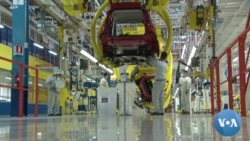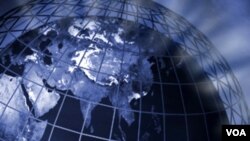ໃນກາງເດືອນພະຈິກນີ້, ຜູ້ຕາງໜ້າການຄ້າຂອງວໍຊິງຕັນ ຈະໄປນະຄອນຊານຟຣານຊິສໂກ ເພື່ອຈັດກອງປະຊຸມສຸດຍອດການຮ່ວມມືຂອງບັນ ດາຜູ້ນໍາດ້ານເສດຖະກິດ ເອເຊຍ-ປາຊີຟິກ ໃນອາທິດນີ້. ບັນດານັກຊ່ຽວຊານທາງດ້ານການຄ້າກ່າວວ່າ ສະຫະລັດ ໄດ້ຫັນປ່ຽນຈາກການຄ້າເສລີແບບບໍ່ຈຳກັດ ແລະ ໄປສູ່ນະໂຍບາຍເປົ້າໝາຍທາງດ້ານການຄ້າ, ເຊິ່ງອາດຈະຊ່ວຍໃຫ້ວໍຊິງຕັນ ດຶງດູດບັນດາປະເທດ APEC ມາລົງທຶນໃນຂະບວນການຜະລິດຂອງສະຫະລັດ ທີ່ຂະຫຍາຍໂຕຢູ່ແລ້ວໃຫ້ເພີ້ມຂຶ້ນຕື່ມ. ເຈສຊິກ້າ ສໂຕນ (Jessica Stone) ມີລາຍງານກ່ຽວກັບເລື້ອງນີ້, ທິບສຸດາ ມີລາຍລະອຽດມາ ສະເໜີທ່ານ.
ຈາກໂຮງງານຜະລິດ semi-conductor ໃນລັດແອຣິໂຊນາ, ລັດໂອໄຮໂອ ແລະລັດນິວຢອກ ໄປຮອດຜູ້ຜະລິດແຜງພະລັງງານແສງອາທິດໃນລັດຈໍເຈຍ ໄປຈົນເຖິງໂຮງງານຜະລິດກັງຫັນລົມໃນລັດໂຄໂລຣາໂດ, ການຜະລິດກຳລັງ ຈະກັບຄືນມາສູ່ດິນແດນຂອງສະຫະລັດອີກຄັ້ງ.
ທ່ານນາງໂຣສແມຣີ ໂຄສ (Rosemary Coates) ຈາກສະຖາບັນ ຣີຊໍຣິງ (Reshoring) ກ່າວຜ່ານຊູມວ່າ:
"ພວກເຮົາຢູ່ໃນສິ່ງທີ່ພວກເຮົາເອີ້ນວ່າ ສຸດຍອດຂອງວົງຈອນການຜະລິດ."
ທ່ານນາງໂຣສແມຣີ ໂຄສ, ຜູ້ບໍລິຫານໃຫຍ່ຂອງສະຖາບັນ Reshoring, ເຊິ່ງ ເປັນສະຖາບັນບໍ່ຫວັງຜົນກໍາໄລ ທີ່ສະຫນັບສະຫນູນການຜະລິດຢູ່ໃນສະຫະລັດ.
ທ່ານນາງກ່າວຜ່ານຊູມວ່າ:
“ການລົງທຶນໃນອະສັງຫາລິມະຊັບດ້ານອຸດສາຫະກຳແມ່ນເພີ່ມຂຶ້ນ 30 ເປີເຊັນ ໃນປີນີ້. ຂ້າພະເຈົ້າໄດ້ໂອ້ລົມກັບນັກພັດທະນາສອງສາມຄົນ ແລະແທ້ຈິງແລ້ວ ໂອ້ລົມຢູ່ໃນກອງປະຊຸມໃຫຍ່ໃນອາທິດທີ່ຜ່ານມາ ໃນບ່ອນທີ່ບັນດາຊຸມຊົນການ ພັດທະນາອຸດສາຫະກໍາທັງຫມົດແມ່ນມີຄວາມຕື່ນເຕັ້ນ. "
ຊ່ຽວຊານທາງດ້ານການຄ້າເວົ້າວ່າ ສູດສໍາລັບວົງຈອນທີ່ສຸດຍອດນີ້, ແມ່ນການປະສົມປະສານເງິນຈໍານວນຫຼາຍຕື້ໂດລາໃນແຮງຈູງໃຈການຜະລິດ ພາຍໃຕ້ລັດຖະບານຂອງ ທ່ານໄບເດັນ ພ້ອມດ້ວຍຂໍ້ຈໍາກັດທາງດ້ານພາສີ ແລະ ຂໍ້ຈໍາກັດທາງດ້ານການຄ້າທີ່ລັດຖະບານຂອງ ທ່ານທຣໍາ ໄດ້ວາງອອກມາ.
ທ່ານເຈມີສັນ ເກຣຍ (Jamieson Greer) ເຄີຍດຳລົງຕຳແໜ່ງເປັນທີ່ປຶກສາພາຍໃຕ້ຜູ້ແທນການຄ້າຂອງສະຫະລັດ ທ່ານໂຣເບີດ ໄລຈ໌ທາຍເຊີ (Robert Lighthizer).
ທ່ານເຈມີສັນ ເກຣຍ, ອະດີດທີ່ປຶກສາ USTR ກ່າວຜ່ານຊູມວ່າ:
"ພວກເຮົາຕ້ອງຮັບຮູ້ວ່າ ລັດຖະບານ ທ່ານທຣໍາ ໄດ້ຜ່ານ NAFTA ໃໝ່ ທີ່ຊຸກຍູ້ການຜະລິດຂອງສະຫະລັດຫຼາຍຂື້ນ, ແລະພວກເຂົາເຈົ້າໄດ້ວາງອັດຕາ ພາສີຕໍ່ ຈີນ ໂດຍບໍ່ຊຸກຍູ້ການນໍາເຂົ້າຊິ້ນສ່ວນລົດໃຫຍ່ ແລະລົດໃຫຍ່ຈາກປະ ເທດຈີນ."
ຈົນເຖິງປັດຈຸບັນນີ້, ປະທານາທິບໍດີ ໂຈ ໄບເດັນ ໄດ້ຮັກສາການເກັບພາສີຂອງອະດີດປະທານາທິບໍດີ ດໍໂນລ ທຣໍາ ຕໍ່ສິນຄ້າຂອງຈີນ ແລະ ການຫ້າມສົ່ງອອກເທັກໂນໂລຈີຂອງສະຫະລັດໄປຍັງບັນດາບໍລິສັດຂອງຈີນຄື ບໍລິສັດ ຫົວເວີ່ຍ (Huawei). ລັດຖະບານທັງສອງ ໄດ້ສະຫນັບສະຫນູນການປະສົມ ປະສານຂອງການຫຼຸດຜ່ອນລົງ ແລະການຈໍາກັດທາງດ້ານການຄ້າທີ່ຖືກອອກ ແບບມາເພື່ອປົກປ້ອງຄົນງານຊາວອາເມລິກັນ ແລະນະວັດຕະກໍາໃໝ່ຂອງ ອາເມຣິກາ, ດັ່ງທີ່ຜູ້ຕາງຫນ້າດ້ານການຄ້າຂອງສະຫະລັດ ທ່ານນາງແຄັດເທີຣີນ ທາຍ (Katherine Tai) ໄດ້ອະທິບາຍຢູ່ສູນກາງຄວາມກ້າວຫນ້າຂອງ ອາເມລິກາໃນເດືອນຕຸລາຜ່ານມານີ້.
ທ່ານນາງກ່າວວ່າ:
"ດັ່ງນັ້ນ ບໍ່ວ່າຊິເປັນການສະໜອງຜ່ານລະບົບຕ່ອງໂສ້ການສະໜອງສິນຄ້າ, ໂດຍຜ່ານການປະສານງານດ້ານການປ້ອງກັນຕໍ່ນະໂຍບາຍທີ່ບໍ່ຍຸດຕິທໍາ, ພວກເຮົາກໍາລັງຊອກຫາວິທີທີ່ດີກວ່າ ທີ່ຈະຮັບຮູ້ສິ່ງທ້າທາຍຕ່າງໆທີ່ພວກ ເຮົາໄດ້ປະເຊີນມານັ້ນ."
ທ່ານເກຣຍ ກ່າວວ່າ ທ່າທີດ້ານການຄ້າໃໝ່ຂອງອາເມລິການີ້ ແມ່ນເຫັນໄດ້ຊັດເຈນໃນຂອບເຂດເສດຖະກິດອິນໂດປາຊີຟິກ ຫຼື IPEF, ເຊິ່ງກໍາລັງເຈລະຈາກັນລະຫວ່າງບັນດາປະເທດ APEC. ບໍ່ຄືກັນກັບສັນຍາທາງດ້ານການຄ້າທີ່ກວມ ລວມໃນໄລຍະຜ່ານມາຄື, IPEF, ທ່ານກ່າວ, ໂດຍເພີ່ມທະວີທາງດ້ານການຄ້າ ຜ່ານເປົ້າຫມາຍ ແລະບາດກ້າວທີ່ເພີ່ມຂຶ້ນ.
ທ່ານເກຣຍ ກ່າວຜ່ານຊູມວ່າ:
"ຂ້າພະເຈົ້າຄິດວ່າ ປັດຈຸບັນນີ້ພວກເຮົາມີວິທີການເຂົ້າເຖິງໃຫມ່, ແລະສິ່ງທີ່ຂ້າ ພະເຈົ້າຫວັງກໍຄື ມັນບໍ່ແມ່ນການຕໍ່ຕ້ານວິທີການເຂົ້າເຖິງທາງດ້ານການຄ້າ. ແລະອີກເທື່ອຫນຶ່ງ, ມັນບໍ່ແມ່ນວິທີຂອງການປົກປ້ອງ, ແຕ່ມັນເປັນວິທີການເຂົ້າເຖິງທີ່ຈິງຈັງ."
ທ່ານນາງ ໂຄສ ກ່າວວ່າ ວິທີການເຂົ້າເຖິງນີ້ ຍັງເປັນວິທີທີ່ເໝາະສົມກັບຍຸດທະສາດໃຫ້ຄວາມສໍາຄັນຂອງບັນດາບໍລິສັດອາເມລິກັນທີ່ທັນສະໄໝ, ເຊິ່ງເປັນໜຶ່ງໃນການເລືອກເພື່ອຜະລິດສິນຄ້າທີ່ໃກ້ຊິດກັບຜູ້ຊື້, ດັ່ງນັ້ນ ເຂົາເຈົ້າຈຶ່ງສາມາດຫລຸດຜ່ອນການປ່ອຍອາຍພິດລົງໄດ້.
ທ່ານນາງກ່າວຜ່ານຊູມວ່າ:
ໃນເວລາພວກເຈົ້າຫຼຸດຕ່ອງໂສ້ການສະໜອງສິນຄ້າໃນທົ່ວໂລກລົງ, ເຈົ້າຍັງຈະ ຫຼຸດຜ່ອນອາຍພິດຄາຣ໌ບອນທີ່ສໍາຄັນຂອງເຈົ້າລົງໄດ້ອີກດ້ວຍ.”
ທ່ານນາງ ໂຄສ ກ່າວວ່າ, ນີ້ແມ່ນໃບຫນ້າໃຫມ່ຂອງ Made in America.
In mid-November, Washington’s trade representatives will be in San Francisco for the Asia-Pacific Economic Cooperation Economic Leaders' Week. Trade experts say the US has moved away from unlimited free trade and toward targeted trade policies, which could help Washington attract more APEC nations to invest in a U.S. manufacturing boom already underway. VOA’s Jessica Stone reports.
From semi-conductor plants in Arizona, Ohio and New York….to solar panel makers in Georgia….to windmill manufacturing in Colorado – manufacturing is coming back to U.S. soil.
Rosemary Coates, Reshoring Institute, Zoom
“We are in what we call a manufacturing super-cycle.”
Rosemary Coates is the executive director of the Reshoring Institute, a nonprofit that supports manufacturing in the United States.
Rosemary Coates, Reshoring Institute, Zoom
“Industrial real estate investment is up by 30% this year. I've talked to a couple of developers and actually spoke at a big conference last week where the industrial development community is all, all excited.”
The recipe for this super-cycle, say trade experts, is the combination of billions of dollars in manufacturing incentives under the Biden administration and tariffs and trade restrictions imposed by the Trump administration.
Jamieson Greer served as chief of staff under U.S. Trade Representative Robert Lighthizer.
Jamieson Greer, Former USTR Chief of Staff,
Zoom
“We have to recognize that the Trump administration passed a new NAFTA that incentivized more production United States, and they imposed tariffs on China that disincentivize imports of auto parts and autos from China.”
So far, President Joe Biden has kept former President Donald Trump’s tariffs on Chinese goods and his ban of U.S. technology exports to Chinese companies like Huawei. Both administrations supported a combination of subsides and trade restrictions designed to protect American workers and innovation, as U.S. Trade Representative Katherine Tai explained at the Center for American Progress in October.
Katherine Tai, US Trade Representative, Center for American Progress
“So whether that's through supply chains, through coordinating defenses against unfair policies, we are looking for better ways of acknowledging the challenges that we have encountered.”
Greer says this new American trade posture is evident in the Indo-Pacific Economic Framework, or IPEF, which is being negotiated between APEC nations. Unlike the comprehensive trade agreements of the past, IPEF, he says, increases trade through targeted and incremental steps.
Jamieson Greer, Former USTR Chief of Staff, Zoom
“I think that we do have a new approach now, and what I hope is, it’s not an anti-trade approach, and again, it’s not a protectionist approach, but it’s a pragmatic approach.”
Coates says it’s also an approach that fits the strategic priorities of modern American companies — one of choosing to produce goods closer to the buyer so they can reduce emissions.
Rosemary Coates, Reshoring Institute, Zoom
When you shorten global supply chains, you also reduce your carbon footprint. “
This, says Coates, is the new face of Made in America.






